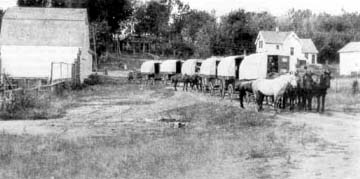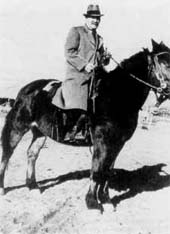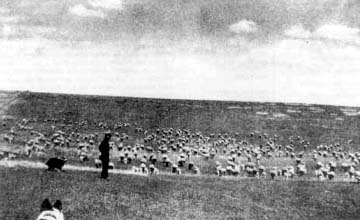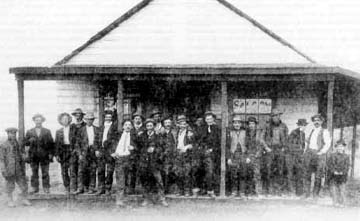

| Ethnic Industries for Migrants: Basque Sheepherding in the American West | |||||||||||
| Gloria Totoricagüena Egurrola | |||||||||||
Large scale Basque emigration to the United States has ceased and those new immigrants now entering the country are generally graduate students or well-educated professionals with artistic and corporate connections for employment. They leave a Basque Country with freely elected governments, and a European Union with relative economic stability. This was not always the case, and in fact, traditional Basque emigration to the United States at the end of the 1800s and the beginning of the 1900s escaped what could be described as almost the opposite circumstances. Following the Carlist Wars of the 1830s and 1860s, economic stagnation and production decline, and political upheaval throughout, Basques experienced many factors pushing them out of their homelands. Access to information networks about possible economic opportunities and assistance was relatively easy to come by. Emigration out of the Basque Country was nothing new and was a common option. What were indeed new factors in the 1860s were the discovery of gold and silver in California, Nevada, Oregon and Idaho, and the possibility to move west by train across the United States, instead of traveling by boat around the American continent. The completion of the Transcontinental Railroad in 1869 facilitated the movement of people across the territories to the west, where public lands were utilized free of charge for grazing animals, and populating the towns was a priority.
Though the first Basques to migrate to the United States did so after initially emigrating to Argentina and Chile, they traveled to California in the search for gold. However, though not all miners would find valuable minerals, they did need to eat everyday, and the agricultural business of producing foodstuffs grew tremendously. Basque immigrants turned their attention to raising cattle, and later to raising sheep. Pedro and Bernardo Altube (who had emigrated from Oñati, Gipuzkoa to Argentina, and from Argentina to California in the 1850s), became livestock barons of cattle when in 1873 they created their Spanish Ranch in Independence Valley, Nevada near Elko. In 2002 it still remains one of the largest ranches in the entire United States. Several Basques who had arrived in the California San Joaquin Valley moved their livestock herds east and north into Nevada, New Mexico and Arizona. Once the railroad connected the east coast to the west coast, the safer, faster and cheaper travel enabled many more Basques to immigrate to the western United States after crossing the Pacific and landing in New York. Men began to send for their sons, brothers, and cousins and eventually wives, daughters and sisters. For the majority, the economic means to provide for their families were related to agriculture and the sheep industry. The largest immigration of Basques with intentions to work in the sheep industry occurred between 1900-1930. The demand for lamb and wool was high, and the profit margin also high. Ranchers could graze their sheep free of charge on massive tracts of public lands and sheepherding in the United States became synonymous with itinerant grazing- moving herds constantly to new pastures and new regions were there were nutrients. In the High Desert this was often difficult, and sheepherders were required to move their herds every single day looking for feed as well as water. For the sheepherder, this lifestyle was extremely taxing and lonely.
Typically, a recently arrived Basque sheepherder worked for another already established Basque business and was paid annually. Many chose to have their pay in head of sheep rather than money, in order to begin their own herds, and an average band of sheep ranged in number from nearly two thousand animals to two thousand five hundred. This was not the sort of sheepherding any of these Basques might have been accustomed to, or had ever even seen. Many Basque sheepherders interviewed decades later still remember their fright at arriving to the United States and reaching their destinations, only to be taken to the mountains and left with supplies and a band of two thousand sheep, and then told, "See you in a month." Most were completely untrained and unprepared for the physical endurance needed to care for so many animals, and were certainly ill equipped to deal with the psychological and emotional loneliness of the range. During the winter months when the sheep were down in the valleys and the men were in town, they stayed at the various Basque boarding houses reveling in euskera, Basque music and dance, receiving news from the Old Country, and hoping to meet Basque women. The boarding houses served many roles and filled needs for the sheepherders including as social, economic, ethnic identity maintenance, and information gathering environments. Problems emerged between the itinerant sheepherders moving their bands constantly on public grazing lands, and the cattlemen doing the same. Cattlemen complained that the itinerant Basques allowed their sheep to overgraze the lands, ruining the chances for quick re-growth. The Idaho territorial legislature passed legislation preventing sheepherders from bringing their sheep within two miles of any cattle range or any human habitation. A 1917 State of Idaho Supreme Court case, Omaechevarria v. State of Idaho upheld the earlier law of separating the sheep and cattle, and the United States Supreme Court affirmed the decision to give preference to the cattle owners in prior occupancy of the public lands. Cattlemen also complained that the majority of Basques were not United States citizens and were benefiting from U.S. lands and public policies and then sending their profits to their homeland and not reinvesting or buying property in the United States.
In 1934, the United States Congress passed the Taylor Grazing Act, which placed an additional 173 million acres of land into federally controlled grazing districts. The new requirements for grazing on these public lands included paying fees and following a specified schedule for all of those using the land, but most importantly it originated the requirement that all of those wishing to use the federal lands had to establish a base property which they privately owned, in order to be eligible for the public lands grazing rights. Land allocation was determined by government officials and cattle ranchers serving on advisory boards- which were keen to deny access to the itinerant Basque sheepman. Now, Basques who migrated to the American west in search of quick riches and profitable sheep grazing were faced with long-term investments of having to purchase land. The Immigration Act of 1924 (limiting the annual number of Spanish nationals that could enter the United States), the economic Depression beginning with the stock market crash in 1929, together with the Taylor Grazing Act of 1934 curbed economic opportunities for Basques migrating to the United States, and though the flow from Euskal Herria decreased, it did not stop. During and after the Second World War, there was an agricultural labor shortage in the United States and sheepherders were needed. Owners offered a contract guaranteeing the payment of the voyage in exchange for a commitment of three to five years of work with the same outfit. However, once the sheepherder's debt was paid off they often left the business looking for other employment closer to the cities, in construction, in farming, and in any other field that allowed them a more fulfilling lifestyle. Senators from the western States passed legislation giving permanent residency to those Basques who had illegally entered the United States, in hopes of luring them back to the sheep industry. In 1950, the United States Senator from Nevada, Patrick McCarran, and the Congressional Representative of Nevada, Walter Baring, worked together to pass legislation known as the "Sheepherder Bills". These laws brought about changes to immigration laws that allowed skilled laborers to enter the country if employers specified that this job could not be filled by anyone in the United States. Sheep industry employers argued that no one could perform the sheepherding tasks the way that the Basque had and could, and that they needed to facilitate the entry of Basques for the sheep industry. They were allowed three-year contracts which were renewable, but once the contract had been completed, the herder was free to seek other employment and the United States government allowed the herder to apply for permanent residency if they desired it.
In 1960, the California Range Association established the Western Range Association, which would function at the national level. Joshe Mendiburu was the President and the principal representative was Germán Pizarro, with the goal of recruiting Basques to come to the American west and work as sheepherders. The Western Range Association negotiated with the central government of Spain and established an office at the American consulate in Bilbao from which they recruited hundreds of Basques. Between 1957 and 1970, the Range Association received 5,495 applications for sheepherding and 95% of those were from Basques from Nafarroa and Bizkaia. However, as the economy of the Basque Country improved, fewer Basques wanted or needed to emigrate for economic reasons and the Western Range Association began to recruit sheepherders in Peru (1971) and in Mexico (1973). During the 1960s, sheepherders were paid an average of $200 per month for inexperienced males, and $300 per month for experienced workers. During the 1970s the closing of Basque immigration related to sheepherding resulted from three major factors: competitive salaries in the Basque Country itself, cheaper labor from South America, and an overall decrease in the demand for sheepherders in the United States. In 1966, there were approximately 1200 Basque sheepherders working in the United States, and by 1976 there were only 106 Basques with sheepherding contracts. Basques dominated the sheep industry in the United States for almost exactly one hundred years beginning with the establishment of the Altube brothers' Spanish Ranch in Nevada in 1873. By the 1970s, most of the second and third generation Basques had moved into different industries, occupations, and professions, leaving behind agricultural labor. However, Basque ethnic identity in the United States remains tied to the collective past they share of sheepherding as the door opener to the United States, and even those Basques whose families never were a part of the sheep business still preserve this significant aspect to the history of Basque development in the West. Dr. Gloria Totoricagüena Egurrola, Center for Basque Studies. University of Nevada, Reno totorica@unr.edu |
Euskonews & Media 212. zbk (2003 / 05-30 / 06-6)
Dohaneko harpidetza | Suscripción gratuita | Abonnement gratuit |
Free subscription
Aurreko aleak | Números anteriores | Numéros précedents |
Previous issues
Kredituak | Créditos | Crédits | Credits
Euskomedia: Euskal Kultur Informazio Zerbitzua
Eusko Ikaskuntzaren Web Orria
webmaster@euskonews.com
| QUIENES SOMOS | Política de privacidad | Avisos Legales | Copyright © 1998 Eusko Ikaskuntza |




